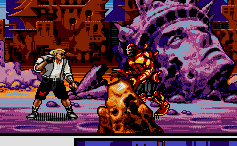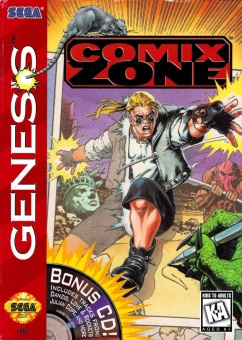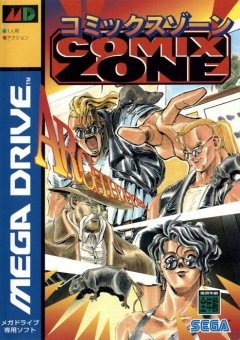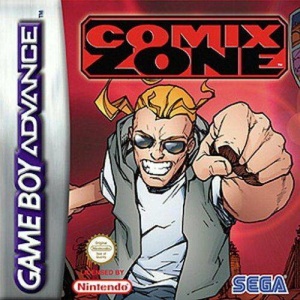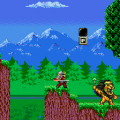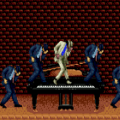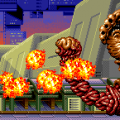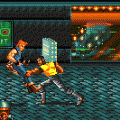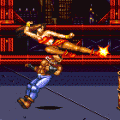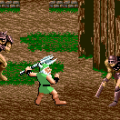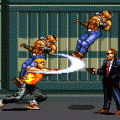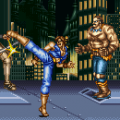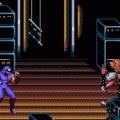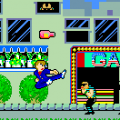Written By Sotenga
Sega was at its zenith in the middle of the nineties. Before the looming threat of 32-bit challenged their resources, Sega had a diverse team of multiple development studios working on many projects all at once. One of their divisions was Sega Technical Institute (STI), an American-based team who developed Kid Chameleonand Sonic Spinball alongside converting Puyo Puyo into Dr. Robotnik’s Mean Bean Machine, all three considerable classics for the system in the West. In 1995, the Genesis had come pretty far along, but was on its way out as the next generation of CD-based consoles came into the fold, and after the relative failure of the Sega CD, Sega attempted to step their game up with the Sega Saturn. Between the Sega CD and the Saturn was an odd period of Genesis support with a deluge of ridiculously advanced games that taxed the limits of the system, including’s STI’s offering of Comix Zone, one of the more beloved games from the Genny’s twilight years.
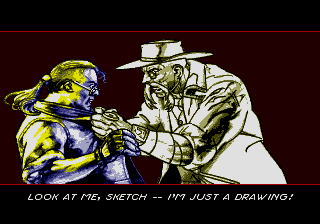
The game’s premise involves the eponymous “Comix Zone” as an illustrated story depicting an onslaught of aliens and mutants attempting to further ravage a post-apocalyptic Earth as the New World Empire defends it against their invasion. This tale is based on the vivid nightmares of its writer and artist, Sketch Turner, a hopefully soon-to-be-famous cartoonist and part time rock musician. He doesn’t have much going for him, living in a New York apartment with Roadkill, his pet rat, as his only company. However, things get horribly weird when a chance bolt of lightning strikes his work-in-progress comic and brings to life one of his own characters. Unluckily, this character is Mortus, the main villain, and he jumps out of the pages to force Sketch into the tumultuous world of Comix Zone.

In the real world, Mortus is only made out of ink and paper, so he intends to kill Sketch in Comix Zone to steal his life and make himself a real entity of terror. In the zone, Sketch finds help from General Alissa Cyan, a military representative who thinks he is the “Chosen One” destined to save the world, to which Sketch initially protests. Yet while Sketch thinks he’s way in over his head, it seems that since he’s become the main superhero of his story, he’s gained uncanny strength and fighting abilities which may give him what it takes to beat the snot out of the bad guys. Considering Mortus is now drawing the comic and actively attempting to murder Sketch, can our hero survive and take control of his own creation? Is Alissa’s faith justified in Sketch’s potential to save both the fictional world and the real one? And can Roadkill get something to eat already, preferably lots of cheese?

Comix Zone is basically a tribute to comics in general, yet is not too overtly influenced by any particular story. The premise of mutants lurking in New York’s sewers may be faintly reminiscent of the Teenage Mutant Ninja Turtles, but it’s otherwise a fairly creative world that Sketch has devised for his unlikely deathtrap. The game itself is a bit hard to cap as a straight genre, but it mostly plays as a sidescrolling beat-em-up with elements of platforming and puzzles wedged in. The major difference from the likes of Streets of Rage or Final Fight is that the action only takes place on a single plane. Sketch must survive the pages of his own comic book by whomping on whatever enemies are in front of him and figuring out how to move onto the next panel. When Sketch can move on, a yellow arrow points away from his current panel, allowing him to flip over the panel border into the next scene. Some moves from Sketch and enemies will rip through the pages to reveal the papery underside, and the hand of Mortus will often appear to draw on new hazards for our hero. Even when you die, Sketch’s body will turn into pencil sketches and get crossed out by Mortus’ marker.

There’s a lot of graphical detail that constantly reminds the player that this game is called Comix Zone for a reason. All the above mentioned touches really do make you feel as if you’re playing a comic as much as you’re reading it, and Sketch often tosses out a bunch of cheesy and silly lines when talking smack to the bad guys or babbling to himself. The level of detail in the backgrounds is astounding and sometimes terrifying, ranging from the collapsed Statue of Liberty in the second panel of the first stage to the nightmarish reds and greens of the mutant-ridden sewers. Later levels exhibit snowy mountains, East Asian temples, gloomy caverns and dilapidated wrecked ships to provide an impressive range of landscapes that prevent the game from feeling repetitive. Every color in the Genesis’ palette is put to the test to replicate the bright appearance of American comic books, and it succeeds to create one of the best dang looking games on the system.

Alongside its visuals is one of the most unorthodox and beloved original soundtracks amongst late-era Genny games. The music is composed by Howard Drossin, who started out as the music man to Sonic Spinball and contributing to Sonic 3 & Knuckles‘ sound design before moving into film music while still occasionally composing for games as well. Comix Zone has some of the most eclectic music ever tailored for the Genesis sound chip, and considering that the American GEMS sound driver doesn’t often churn out high-quality audio, it’s impressive to behold what Drossin did with the tools at his disposal. Some tracks ring with a surf rock sort of vibe (particularly those in the first episode), others with a bit of heavy metal, and yet others still seemingly influenced by nineties grunge rock. The most prevalent instrument is a sort of electric guitar that sounds a bit grating at first, but it really fits in well with the overall atmosphere of the game. Considering Sketch himself is a proclaimed rock musician, it almost sounds like the type of stuff he’d compose. The music can be a bit of an acquired taste, but it stands out as one of the more impressive works of music for the Genesis. There are at least three tracks for every stage, changing when Sketch jumps into the next area, and often appropriate to the current surroundings. It’s this sort of dynamism that emphasizes Comix Zone‘s technical prowess.

So the presentation is overall illustrious, and there’s some good gameplay beneath the luster, albeit with some flaws here and there. Sketch must either beat the snot out of at least one enemy or figure out a puzzle to move on to the next panel, and when it comes to the former case, he has quite a few moves at his disposal. While there’s only one attack button, using it in context with the control pad allows him to use punches, high kicks, low kicks, uppercuts, and other moves, amidst jumping attacks. By default, Sketch blocks automatically as long as he’s not attacking, though this can be assigned to a separate button if you’re using a six-button controller. Additionally, he can tear off part of the page and use it as a paper airplane, at the expense of some health. His invetory allows him to carry up to three items, like grenades, iced tea to boost his health, and most importantly, his pet rat Roadkill. The rodent’s tail can stun enemies to give Sketch an edge in a fight, and he also pulls switches and uncovers hidden items to make things much easier for our hero. He’ll need all the aid he can get, too, as there are several types of enemies, who can all be pretty tough to defeat. Mortus continues to revive enemies by drawing them back into the panel and sometimes even duplicating them, but you’ll ideally learn how to fight each type the more you duel against it.

Your first opponent is Gravis, a bulky mecha-man who uses brute strength and some sort of weird metallic coil to beat you down. Soon after him follows Strigil, a squid-headed assassin who utilizes twin hookswords, fireballs, and teleportation to confuse and shred you to bits. Some sections toss slimy Spawn Mutants at you with sharp sickles for arms and acid goo breath. Lesser mutants attack you as Cocoon Crawlers, small slithery scorpion-esque things who aren’t much of a threat on their own but often hinder you as you deal with other enemies or obstacles. Then there are Flying Creatures, obnoxious gray winged jerks who sting at you with their pointy tails and are often placed in the least appropriate of areas. Styx is a monk wielding a staff which he uses to swiftly attack and defend, launch fireballs, and even jump around on like a pogo stick while energy rings try to singe you. Mongoria is a female warrior who jumps repeatedly around the screen and tosses her bladed hair at you, a tough opponent save for a very peculiar weakness against one of Sketch’s items. Finally, the rarely-encountered Pelagus is best left rare, as this mini-Cthulhu fires out bouncing slime wads and lays mines on the ground which can blow off about half of Sketch’s lifebar. Above the semi-common goons are three unique bosses, one for the end of each episode, and while they seem tough at first, they each have a special trick where you use the environment against them to speed up the process of their deaths.

It could be said the bosses are the easiest part of the game (perhaps except for the second one), but the stages themselves can be quite tough trials. If anything, Comix Zone is one of the most unforgiving and devious games ever released during the 16-bit era, and it even gives many 8-bit action games a run for their pixels. For starters, enemies can be surprisingly smart and counter your attacks frequently, and it can take a good chunk of your life to beat some of the more devious foes like Styx or Pelagus in a straight fight. There are also some fiendish puzzles and traps that will usually require a chunk of your life to clear. Sketch can shoulder-ram solid objects but it takes away a small bit of health, and there are several points where you have to brute-force obstacles to get rid of them. Unless you happen to have a bomb on hand, you will end up paying out some life to advance. The solutions for some areas aren’t obvious, like a devious pit which gradually lowers into a massive bear trap or minefields that require some tricky jumping to avoid. Undoubtedly the most vile points involve Flying Creatures who can sting you just right to knock you into a fatal pitfall and instantly blow your game no matter how much life you have left.

However, there are a few cases of where you can choose to jump between different panels, allowing for slightly differing routes through the stages. There are also two endings, depending on how the final battle plays out. In perhaps a nod to Revenge of Shinobi, a female character, this time Alissa, is trapped in a device. You need to go through a few steps to save her, and beat Mortus, or else she’ll be killed, leading to a bummer of a finale.

To top all this off, you only get one life and, at first, no continues to supplement it. Health restoratives are rare, and you don’t even regenerate after completing a stage. However, you can be granted an extra continue or two through circumstances which are not clearly known. Should this happen, Mortus declares that it was too easy to kill you and to have more fun with you. Continuing sends you back to the beginning of the page and with no items, which can make things worse depending on how useful it would be to have Roadkill, a bomb, or whatever else at the moment. The brutality is somewhat offset by the considerably short length of the game. There are really only six levels in all, with none lasting for any prolonged amount of time. Actually attempting to finish it is another matter considering the devious parts where lacking a certain item makes your game much harder and may potentially kill you. Comix Zone‘s difficulty comes to the point where it feels like the game is more eager to punish than reward you for completing certain segments, and hence it is a game that cannot be recommended for everyone.

It’s a shame that for as much of an audiovisual treasure as it is, the core game is a bit shallow and royally unfair. Comix Zone is a diamond in the rough that looks gorgeous yet has some nicks and flaws once you examine it up close with an eyeglass. It is not the hardest game of all time, but it does feel as if its design of forcing you to replay in order to learn what not to do is a bit of a copout as opposed to making the game longer and less frustrating. Still, if not for what it did, Comix Zone still deserves recognition for what it was: A technical marvel for the Genesis that proved the Genny still had what it took in spite of the next console generation threatening to snuff out its existence.

While it eventually did succumb, Comix Zone serves a role for the Genesis similar to what Kirby’s Adventure did for the NES by sending the console out on a technological high note. It’s a shame the gameplay is somewhat disappointing, but it’s not entirely bad and can actually be enjoyable in the right mindset. The concept of the game ultimately sells it along with the sort of “lovable loser” vibe Sketch gives off, with his one-liners and exclamations adding a lot of personality to an otherwise simple character. Perhaps Comix Zone would have felt more at home as a point-and-click adventure game than an action-brawler, but considering the only remarkable adventure title on the Genesis (not counting the Sega CD or 32X) is the surprisingly good Scooby-Doo Mystery, it likely would not have sold very well in that genre.

As it stands, while far from perfect, Comix Zone is nonetheless beloved by Sega aficionados and is something of a cult classic today. Furthermore, while the American and European versions are cheap and easy to find, it received only an exceptionally small print run in Japan, leaving it as an extremely pricey title on the secondhand collector’s market. Perhaps boosting its sales back in the day was a bonus CD for the original North American release to emphasize its nineties appeal, with songs like “I Hate Rock and Roll” by the Jesus and Mary Chain, “Going Down to Die” by Danzig, and “No More Love” by God Lives Underwater. It’s a neat bonus even if these songs have nothing to do with the game proper, a stunt that further drives the nineties-ness of the game as a time capsule for an era when game companies often released a lot of crazy promotional crap to sell their products (like the numerous CDs and comics based on Mortal Kombat). Even more bizarre is the bonus CD that came with the European Mega Drive and Windows PC versions of the game, where Howard Drossin took six songs from the game, remastered them with actual instruments, and even gave them hilariously cheesy vocals. This was eventually released in North America under the incredibly short lived Sega Tunes label (which included other similar reduxed tracks from Sonic and Vectorman, among a few others), and it serves as a very interesting curiosity to say the least.
Comix Zone was ported to the PC around the time when Microsoft was beginning to push Windows 95 as a solid gaming platform competant enough to mimic the action of the consoles. However, it’s a straight port with no enhancements, even running at the same low 320×224 resolution of the Genesis version. The soundtrack is also played through the Windows MIDI system, which is not great.
Comix Zone is still somewhat acknowledged by gamers of today thanks to several modern ports, including an unlikely translation to the Game Boy Advance. It’s generally regarded as a lame port due to sizing down the screen and sprites, the washed-out colors, and using different instruments to play the music, but for a long time it was the only thing that existed for those who missed out on Comix Zone the first time around. Thankfully, more accurate ports would later be released to the Wii’s Virtual Console and the Xbox Live Arcade, and on the Sega Genesis Collection for the PlayStation 2 and PSP, the Sonic Mega Collection Plus, also for the PlayStation 2, as an unlockable game, Sonic’s Ultimate Genesis Collection on PlayStation 3 and Xbox 360, with yet more ports for the PC gaming services Steam and OnLive. These are emulations of the Genesis versions, rather than a native port like the Windows 95 version. There are a few sound errors that diminish the awesome music quality (such as a particularly annoying beep that replaces a faint drum sound in the latter half of stage 1-2’s music), but they’re otherwise seamless ports with accurate controls and graphics.
Screenshot Comparisons
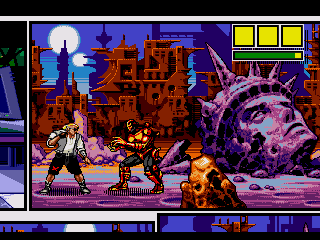
Genesis
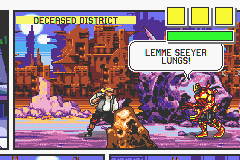
Game Boy Advance
